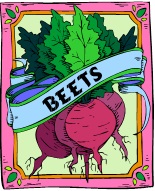 Understanding Seed Catalogs - December 24, 2014 Jeff Schalau, Agent, Agriculture & Natural Resources University of Arizona Cooperative Extension, Yavapai County Pretty soon, seed companies will be mailing their catalogs to their former customers. These catalogs usually make great reading and many contain useful gardening tips. If you are new to gardening, you may not understand all the terminology used. In this column, I’ll try to define some of these terms which should improve your understanding of a given crop, assist in the decision making process, and ultimately have a positive effect on your garden’s productivity. I record my garden information in a 100 page composition notebook. Each year I draw the garden layout, the types and varieties of crops and dates I planted, and try to capture some notes about the crop’s flavor and productivity at the end of the season. I include notes about winter crops (usually leafy greens) and cover crops (non-edible plants which help improve soil quality, save manure nitrogen or fix nitrogen for the following crop, compete with weeds and provide other benefits). As you peruse the seed catalogs, you might want to take notes in your garden notebook to remind you about intriguing crop varieties and other good garden ideas. The first thing you should notice in a seed catalog is the name of the flower or vegetable. If you encounter the words “New” or “Improved”, it often means that particular variety has been improved or changed in some characteristic(s). Some catalogs use icons to indicate key traits, such as a sun for heat tolerance, a snowflake for cold tolerance, or a pot meaning good in containers. Use these icons to help you select seeds when applicable. Another common icon is the red, white and blue “All-America Selections” shield, indicating this variety won this award, being judged by professionals nationwide as superior (more at www.all-americaselections.org). Each year seeds are distributed to approximately 40 sites around the country to be grown and evaluated by a group of impartial judges and horticulture specialists. Vegetables are judged on speed to harvest, harvest yield, taste, growing patterns and resistance to pests and disease. In addition to pest and disease resistance, flowers are judged on formation, color, foliage, fragrance, and length of season. Other designations you might encounter are “F1” and “OP”. These refer to F1 hybrids (first generation, compared to F2 which is second generation) and Open Pollinated. The former are crosses between two parents, to produce a variety with hybrid traits and vigor. If you replant seeds from F1 hybrid plants, they will not produce the same characteristics as the parent plants had. Open pollinated plants, on the other hand, will breed “true” from their seeds when sown as long as pollinators only visited that one variety. Squash plants are an example of a plant which can easily be crossed other varieties making seed – bees may visit many squash varieties and create crosses that are very different from the parent plant. Some plants are self-pollinizing and will breed true, so that even under open pollination conditions the next generation will be (almost) the same. Examples of self-pollinizing plants include peas, beans, tomatoes, and lettuces. Some vegetables such as vine crops and tomatoes will include codes referring to disease resistance. Some of the main ones to watch for on tomatoes for instance are TMV (tobacco mosaic virus), TSWV (tomato spotted wilt virus), V (verticillium wilt), and F (fusarium wilt). Another key point in seed catalog descriptions is days to maturity. This could mean from sowing or in the case of slow crops the days from setting out plants. Check the catalog to make sure what is meant. This is particularly important in cooler areas with shorter growing seasons. Most seed companies have web sites where you can order their catalog or shop on-line. Seed catalogs are a good way to get a wider selection than usually is available in local nurseries or garden centers, especially if you are looking for new or unusual varieties. Many seed catalogs include lots of cultural ideas and helpful pointers that will make you a better gardener. Remember not to get carried away with more than you and your garden space can handle – many seeds will retain viability for multiple growing seasons is stored on a cool, dry location. See below for more information on seed and seed catalogs. Follow the Backyard Gardener on Twitter – use the link on the BYG website. If you have other gardening questions, call the Master Gardener help line in the Camp Verde office at 928-554-8999 Ext. 3 or e-mail us at verdevalleymg@gmail.com and be sure to include your name, address and phone number. Find past Backyard Gardener columns or provide feedback at the Backyard Gardener web site: http://cals.arizona.edu/yavapai/anr/hort/byg/. Additional Resources Pollination of Vegetable Crops University of Georgia Cooperative Extension extension.uga.edu/publications/detail.cfm?number=C934 Disease Resistant Vegetable Cultivars Cornell Cooperative Extension www.gardening.cornell.edu/factsheets/ecogardening/disresveg.html List of Selected Seed Catalogs Organic Gardening Magazine www.organicgardening.com/learn-and-grow/seed-catalog-time Terrior Seeds LLC A Yavapai County, AZ Based Seed Company www.underwoodgardens.com/ All-America Selections Independent, non-profit organization that tests new varieties then introduces only the best garden performers as AAS Winners all-americaselections.org/ |